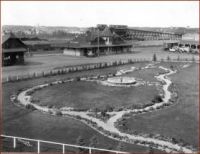|
1907
Red Deer becomes a
divisional point for CPR
reprinted from Red Deer Advocate '100 Years Vol. 1' March 28, 2007
Sometimes major news stories do not
get a lot of attention, at least not at first.
On Dec. 14, 1906, the Advocate printed a two-inch story on the front
page which stated "the action of the Canadian Pacific Railway in
asking the Town Council last evening for rates on an estimated water
supply need of 100,000 to 200,000 (gallons) per day indicates that
the Company contemplates extensive improvement and enlargement at
Red Deer in the near future."
There had been other hints that the CPR had big plans for Red Deer.
A number of improvements had been made in the summer of 1906 to the
CPR yards including the installation of new switches and grades as
well as the construction of new stock pens and a small new
roundhouse.
In October 1906, three carloads of cement arrived in preparation for
construction of a new rail bridge across the Red Deer River.
Still, there was not a full indication of what CPR was planning. The
Advocate speculated that Red Deer might be made a shipping point for
a new rail line east to Stettler and the newly settled areas of East
Central Alberta.
Actually, what the CPR was planning was to make Red Deer the major
divisional point for the main line between Calgary and Edmonton.
That would mean that all the freight trains running along the
Calgary & Edmonton line would have their crews changed at Red Deer.
Moreover, new trains would be assembled or broken up in Red Deer
prior to their departure to other points along the line.
Such a move would involve a major investment in the rail facilities
at Red Deer.
There would be a great many construction jobs while the work was
being done, as well as a significant number of permanent new jobs in
Red Deer once the project was completed.
People could be forgiven for not really believing that such a major
undertaking was imminent. The winter of 1906-1907 was one of the
worst on record. Therefore, not much work was completed --
particularly on the new bridge.
Some further improvements were done during the summer of 1907. A new
coal chute and a water tank were constructed. However, the onset of
a brief, but sharp economic recession again put much of the work on
hold.
In the spring of 1908, the railyards became a bevy of activity and
construction. A large elevated coal tipple was built, the same size
as the ones in Calgary and Canmore.
Work began on a large addition to the roundhouse. A large repair
shop was built.
The station house was enlarged.
Much of the trackage was upgraded to a heavier gauge steel.
On April 27, 1908, the CPR made official what had been obvious for
more than a year. Red Deer was going to be the major divisional
point on the C & E line.
The company estimated that it would spend $130,000 to $150,000 in
additional improvements, including the expenditure of another
$57,000 on the partially completed steel rail bridge across the
river. To put that sum into context, a very good wage in those days
was $1.50 to $2.00 per day.
The company, in its official announcement, indicated that there were
two main factors in the decision. First was Red Deer's location half
way between Calgary and Edmonton.
Second was the ready supply of large amounts of water out of the
river, water being essential to the operation of the steam trains.
In 1910, work began on the "crowning glory" of the whole project.
A beautiful new railroad station was constructed at an estimated
cost of $34,000.
The new structure was to be located in the middle of the west end of
Ross Street. That way it could be clearly seen from the commercial
heart of the community.
|

The Canadian
Pacific Railway's station cost $34,000 was visible from the
commercial centre of Red Deer.
Photo
courtesy of
the Red Deer and District Archives
|
While the new station was large and impressive, Red Deer's economy
continued to boom, in large part due to the impressive new
investments and increase in employment made by the CPR. Within a
year of the station being completed, an addition had to be
constructed on the south end of the station.
It is hard to overstate the importance of Red Deer becoming the
major divisional point on the C & E line.
At the turn of the last century, Red Deer had been a smaller town
than either Innisfail or Lacombe.
Now that it was the transportation and distribution centre for
Central Alberta, Red Deer began to surge ahead. The foundation of
much of Red Deer's future growth and prosperity was now in place.
|



